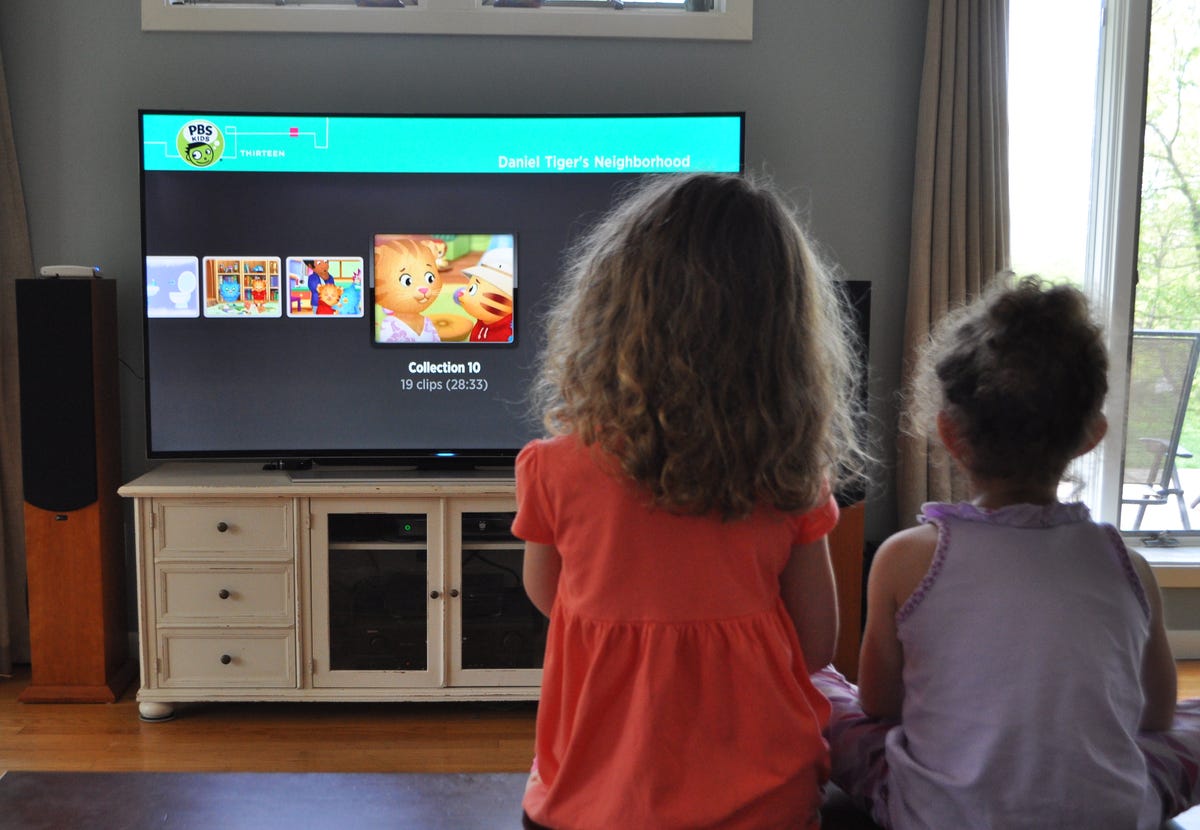
David Katzmaier/CNET
“Are curved TVs a gimmick?”
That was the question I asked back in January. I was fresh off a full week at CES in Las Vegas, where Samsung and, to a lesser extent LG, had spent a significant amount of time and money highlighting curved — and even bendable — TV screens as The Next Big Thing for 2014.
I was skeptical, but pledged to keep an open mind. And now that the curved TVs are hitting the market en masse, it’s time to start putting them to the test.
The curved pitch
In an effort to sway my opinion, Samsung’s people made me an unusual offer for my review of their flagship 65-inch UN65HU9000 curved LED LCD. In addition to sending a review sample to CNET’s TV test lab in Manhattan, they’d also send one to my home, for me and my family to live with for awhile and use as our regular TV, day in and day out.
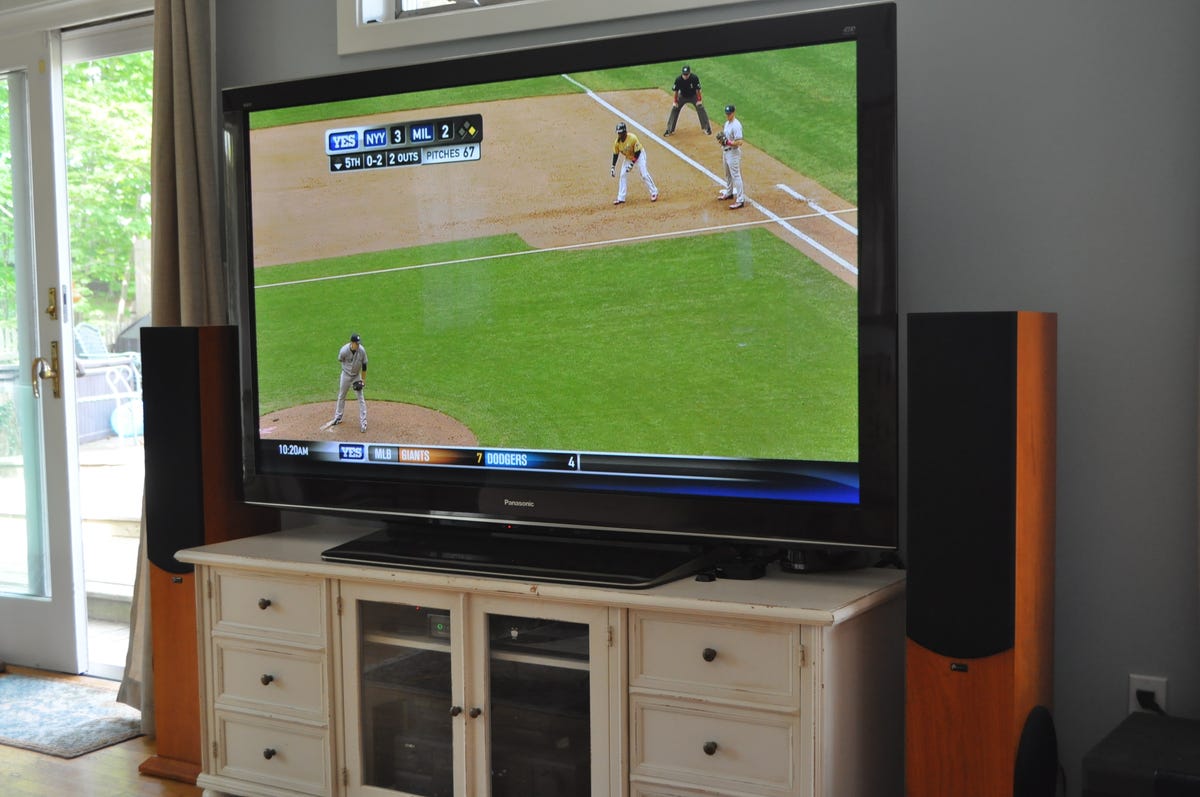

David Katzmaier/CNET
I told them it would be replacing a 65-inch Panasonic TC-P65VT25 , my current everyday TV, CNET 2010 Editors’ Choice and a superb all-around performer (above). I told them I don’t review TVs at home, and in fact this would be the first instance of home TV testing more than a decade of reviewing TVs. They were perfectly aware of my preferences for plasmas over LCDs and, so far, flat screens over curved.
In the end I agreed to a temporary loan mainly because I was curious about a new TV watching experience over the long term. And because in all fairness, maybe my impressions of the curve would change over time. Heck, I might grow to like it, or at least dislike it less. Maybe.
Editor’s Note: For the record, let’s reiterate this important point: As with CNET’s other review samples, I’m not keeping the UN65HU9000. The loan agreement I signed with Samsung stipulated it be returned in less than two months. At the end of that time I’ll send it back and the Panasonic plasma will retake its rightful place in my living room. I’ll be using the second UN65HU9000 in the CNET lab to conduct my formal review, which will appear shortly in the usual CNET format.
The arrival at home
The friendly white-glove delivery guys arrived at my house yesterday around 10 a.m., brought the TV box inside, pulled off the top and then at my request, paused for a moment to let me take it in. Yep, it was curved.
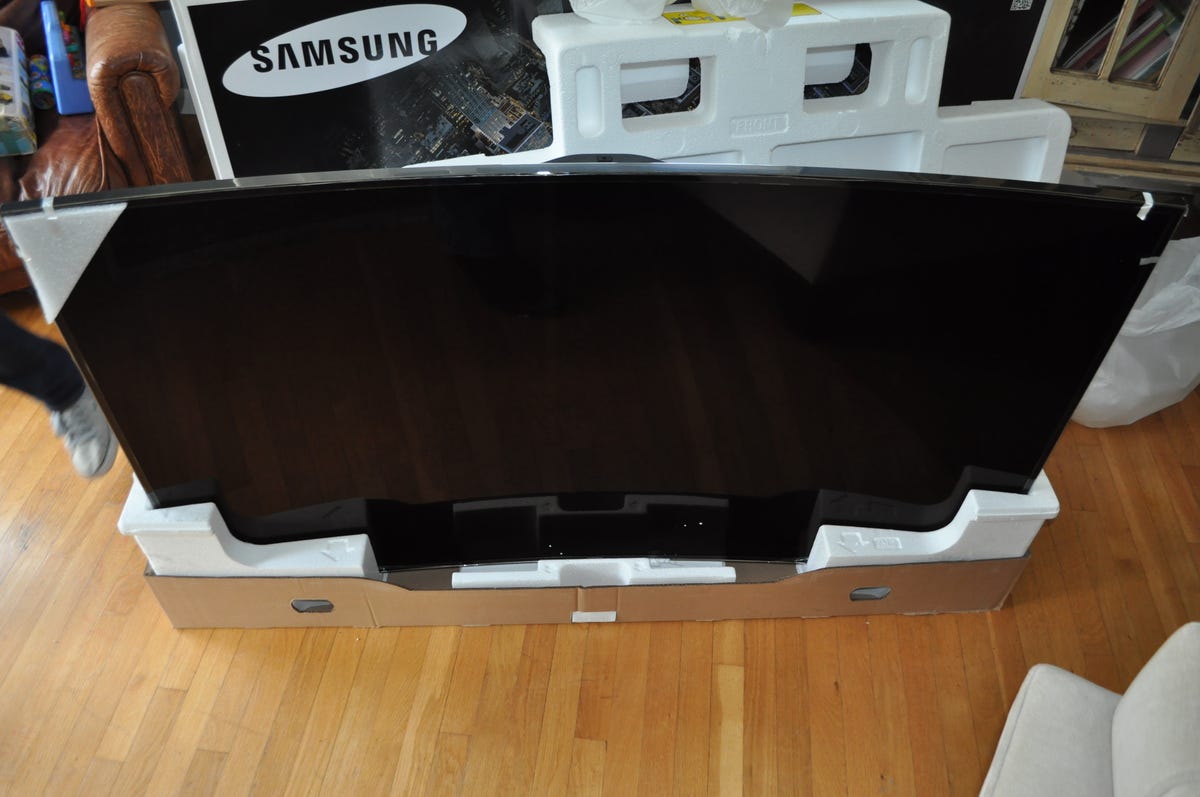

David Katzmaier/CNET
They put it all together on the floor and then proceeded to remove the plasma from our TV stand. Then they hefted up the curved TV in its place, nodded placidly at my assurances that I’d handle the actual hookup myself, and took my old plasma downstairs to the basement for its temporary retirement. They left with my signature and a tip. I have a lot of stairs, and those TVs ain’t light.
Back in the living room I was struck by the way the curve of the set contrasted with the straight lines everywhere else. The TV stand. My tower speakers. Even the windows of the room itself. It definitely looked different, and in my view kinda odd, at least at first. But certainly more futuristic than my old TV, and not just because of the curve. Its lines were slimmer and its form more compact overall than my plasma, with its much thicker bezel and taller stand.
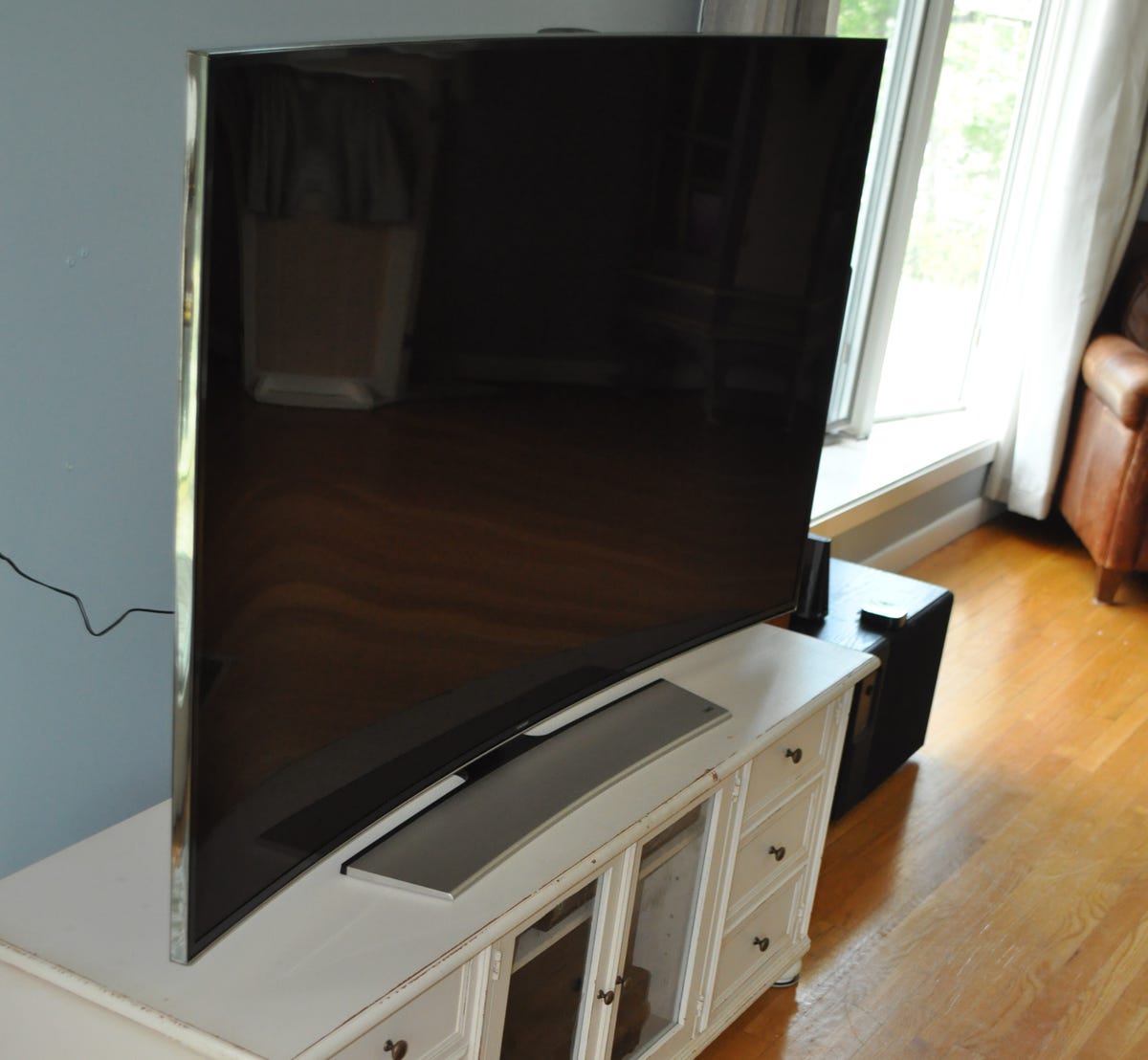

David Katzmaier/CNET
“I don’t like it. When do we get our old TV back?” That was my wife’s first impression after seeing the UN65HU9000 atop her beloved white TV cabinet. Not an auspicious start, but change is always hard.
Out of the mouths of babes
I asked my daughters, 3 and 4 years old, to share their initial observations. They both noticed its reduced size compared to our old TV (even though both are technically 65-inch sets).
“Did you notice anything else about it?” I asked the older one, fishing for a mention of the curve, which to my eye was blindingly obvious. She looked at me quizzically.
“Well, my face looks all weird!” she said at last, turning to gaze at her distorted visage reflected in the TV’s glossy black screen. “When I dance I look all fat!” she added with an infectious cackle, capering around in response to the funhouse reflections.
The younger one wandered in and I asked her what she thought. She cooed a little and walked up to it. “It’s a little baby,” she said fondly of the huge TV.
My wife also expanded her opinion, noting that it looked smaller and too low after our old set. “Aesthetically, the curve looks weird,” she added. “The stand should be black, not silver.” I hadn’t even turned it on, but she told me that didn’t matter as much to her as how it looked in our living room.
She also admitted that after a while she might get used to it. “Maybe if someone had a more modern, minimalist style it think it could look good there,” she said. “But that’s not the style of our home.”
Initial grade of the curve
I spent the next couple of hours hooking everything up, going through Samsung’s initial setup and reprogramming my Logitech Remote so my family could actually use the TV. The only hitch I encountered was when the TV and the OneConnect box, which houses the inputs among other things, didn’t recognize one another at first. After a few minutes of cursing (under my breath; the kids were eating lunch in the next room), restarting the TV and reconnecting the box’s umbilical a few times, it worked.
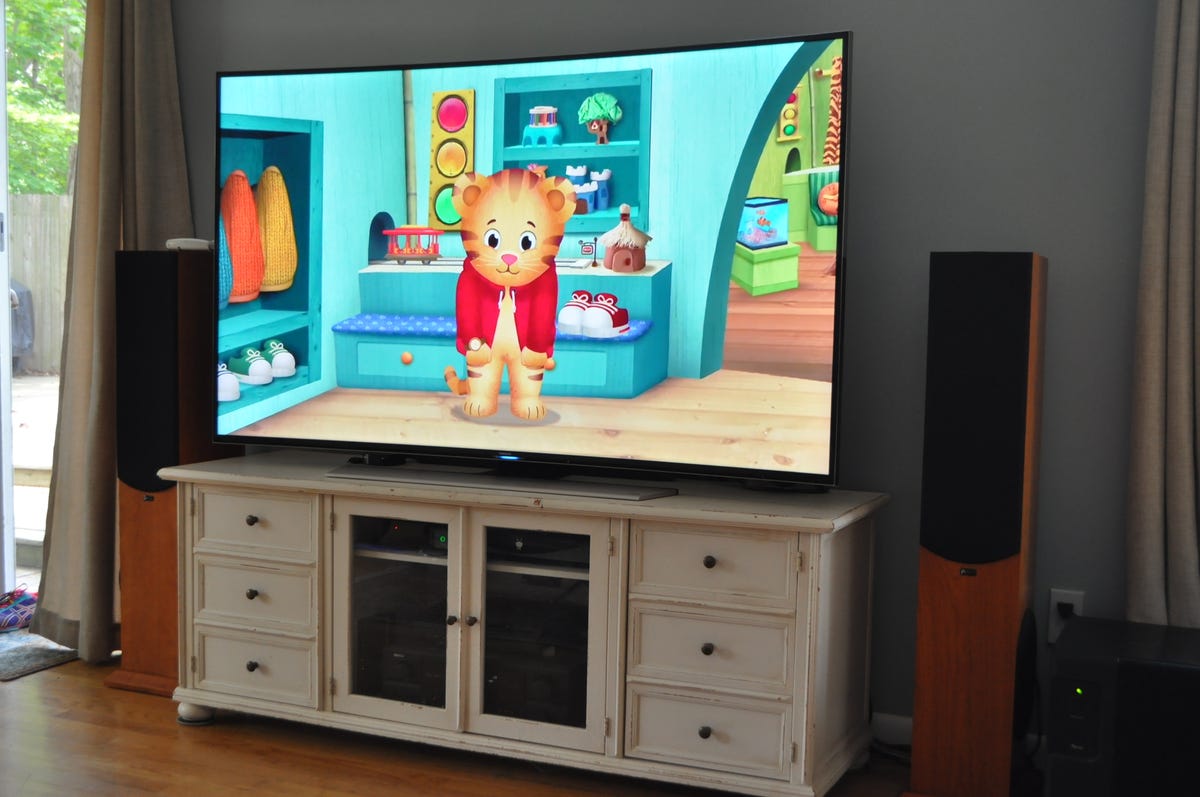

David Katzmaier/CNET
The first program was “Daniel Tiger’s Neighborhood” from the PBS Kids app on Roku. Not my choice, I swear. It looked fine once I’d selected Movie mode and disabled the Auto Motion Plus dejudder (my wife immediately noticed it and, like me, complained about its effects). I didn’t watch anything else till the evening, when my wife and I caught up on “Mad Men” and “Silicon Valley.”
Watching a full program on the Samsung, seated in my traditional spot directly in front of the screen, I quickly forgot about the curve. Yes, in the beginning I was a little distracted by the gentle bend in on-screen graphics and other formerly straight lines, but with regular program material it didn’t bother me nearly as much.
Maybe it’s just because I love those two shows, or that unlike a ball game with its ticker or a movie with letterbox bars, they lack horizontal lines that show the curve more clearly. For whatever reason I wasn’t regularly distracted by the curve while I was watching. My wife concurred. “When I read your articles I thought I’d notice the distortions more, but I really don’t,” she told me.
On the other hand I didn’t feel any more immersed than usual, either. The marketing line is that the wraparound effect of the curve, even from my 10-feet seating distance, provides a more immersive feel. In my living room that wasn’t the case. If anything, I felt a bit less immersed because, as noted, the TV felt a bit smaller than my old one, despite their identical sizes on paper.


David Katzmaier/CNET
My room doesn’t have windows or bright lights opposite the TV, and I didn’t spend a lot of time watching dark shows during the day yet. I did notice one additional reflection when it was turned off, however. From off-angle seats to the right far side, the curve caught more of the two windows opposite than did my flat TV (right). Other than that, I didn’t notice any major differences in terms of reflectivity.
Of course I noticed other image quality differences, for example off-angle washout and seemingly less-defined shadow detail, but those have little to do with the curve — and everything to do with the excellent picture on my Panasonic plasma. I’ll address those in the full review, based as always on on direct comparison against other calibrated TVs in our lab.
As for my home review, my takeaway so far is that the curve is a smaller deal than I thought it would be. In my brief experience it adds neither major problems with distortion nor a significant increase in immersive feeling to my viewing experience.
In case you’re wondering, in the 65-inch size Samsung is currently asking $4,500 for the curved HU9000 , compared to $3,500 for the flat HU8550. If I had to render a verdict now, I’d say the curve itself isn’t worth the extra grand. I’ll have a firmer opinion after a few weeks of living with it.




